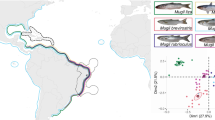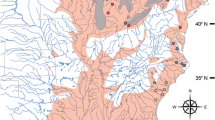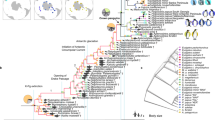Migrating birds may have transported the Balea land snail across vast distances to remote islands.
Abstract
Darwin was fascinated by the transportation of land snails across great swathes of open ocean by birds — he even immersed snails in sea water to see how long they would survive1. Here we follow a molecular phylogenetic trail that reveals the incredible transequatorial dispersal of the land snail Balea from Europe to the Azores and the Tristan da Cunha islands, and back again. This long-distance dispersal is unexpected for what are proverbially considered the most pedestrian of creatures.
Similar content being viewed by others
Main
An allegorical picture2 from the sixteenth century shows a bird carrying a snail (Fig. 1), but it was not until 1921 that the possibility of land-snail dispersal by birds was discussed for Balea3. It was suggested that the exceptionally tenacious slime and arboreal habit of Balea perversa, an ovoviviparous hermaphrodite, could aid passive dispersal by birds3. As land snails occur on even the most remote islands, this must be a frequent event, despite the limited number of well documented cases4.
An eagle is depicted here, but is unlikely to be the bird that transported Balea (see supplementary information). Waders or other migratory birds, which are regular vagrants on mid-Atlantic islands, are more likely vectors.
In 1824, John Gray assigned two new species of land snail from the Tristan da Cunha islands to Balea, a genus of Clausiliidae thought to be restricted to the Palaearctic region, which includes northern Africa and Eurasia to the north of the Himalayas5. The Tristan archipelago consists of three main islands situated midway between South Africa and South America at about 37° S, with Gough Island lying about 350 km to the south-southeast (Fig. 2a). It lies 9,000 km and 8,500 km from the Azores and continental Europe, respectively.
a, Areas where the snails are found. b, Neighbour-joining tree for DNA sequences of cytochrome oxidase subunit I in selected species, with bootstrap support values (1,000 replicates). A smaller International Transcribed Spacer 1 data set corroborates these results (see supplementary information). Lineages from mid-Atlantic islands are in red. The extent of sequence divergence between B. perversa and its sister clade, together with the occurrence of at least eight Balea species on Tristan/Gough8, rule out human introduction of the snails. The sequences of populations of B. heydeni from mainland Europe are extremely similar, suggesting a recent return to the continent.
On the basis of their extreme biogeographical disjunction, these Tristan land-snail species were subsequently transferred to a new genus, Tristania6. Additional species of Tristania were later described from other islands in the Tristan/Gough group7,8. To reach Tristan from either Europe or the Azores, where two Balea species occur9, a hostile gap of nearly 9,000 km has to be bridged, which hardly seems possible for a vulnerable pulmonate.
Despite renewed claims for the generic distinctness of Tristania, including the erection of the subfamily Tristaniinae10, anatomical evidence indicates that Tristania and Balea belong to the same genus8. We have analysed mitochondrial DNA sequence data for subunit I of cytochrome oxidase for different Balea species and find that they confirm this view: our neighbour-joining phylogenetic tree (Fig. 2b, and see supplementary information) indicates that Azorean and Tristan groups of Balea arose from a single ancestral species.
As the Baleinae originally radiated in the western Palaearctic region11,12, the most parsimonious scenario is that first the ancestral species reached the Azores, then, after additional long-distance dispersal, radiations resulted in two species in the Azores and at least eight in the Tristan/Gough archipelago. One of the Azorean species, B. heydeni, reached Madeira and then ‘returned’ to western Europe, where it exists as a distinct species only recently distinguished from B. perversa13 (the European B. perversa reached Iceland relatively late and remains indistinguishable from conspecific European populations).
References
Darwin, C. On the Origin of Species (Murray, London, 1859).
Gheeraerts, M. De Warachtighe Fabulen der Dieren (Pieter de Clerck, Brugge, 1567).
Cockerell, T. D. A. Nature 108, 496–497 (1921).
Rees, W. J. Proc. Malac. Soc. Lond. 36, 269–282 (1965).
Gray, J. E. Zool. J. 1, 61–62 (1824).
Boettger, O. Ber. Thät. Offenb. Ver. Naturk. 17/18, 18–104 (1878).
Odhner, N. H. Proc. Malac. Soc. Lond. 34, 168–173 (1960).
Preece, R. C. & Gittenberger, E. J. Moll. Stud. 69, 329–348 (2003).
Backhuys, W. Land and Freshwater Molluscs of the Azores (Backhuys & Meesters, Amsterdam, 1975).
Schileyko, A. A. Ruthenica 2 (suppl.), 437–564 (1999).
Nordsieck, H. Arch. Molluskenk. 109, 67–89 (1978).
Nordsieck, H. Arch. Molluskenk. 109, 249–275 (1979).
Gittenberger, E., Preece, R. C. & Ripken, T. E. J. J. Conch. (submitted).
Author information
Authors and Affiliations
Corresponding author
Ethics declarations
Competing interests
The authors declare no competing financial interests.
Supplementary information
Supplementary information
(DOC 190 kb)
Rights and permissions
About this article
Cite this article
Gittenberger, E., Groenenberg, D., Kokshoorn, B. et al. Molecular trails from hitch-hiking snails. Nature 439, 409 (2006). https://doi.org/10.1038/439409a
Received:
Accepted:
Published:
Issue Date:
DOI: https://doi.org/10.1038/439409a
This article is cited by
-
Species richness patterns and community structure of land snail communities along an urban-rural gradient in river floodplains
Urban Ecosystems (2024)
-
Phylogeography of Bellamya (Mollusca: Gastropoda: Viviparidae) snails on different continents: contrasting patterns of diversification in China and East Africa
BMC Evolutionary Biology (2019)
-
Indication for selfing in geographically separated populations and evidence for Pleistocene survival within the Alps: the case of Cylindrus obtusus (Pulmonata: Helicidae)
BMC Evolutionary Biology (2017)
-
The history of an invasion: phases of the explosive spread of the physid snail Physella acuta through Europe, Transcaucasia and Central Asia
Biological Invasions (2017)
-
Drivers of Central European urban land snail faunas: the role of climate and local species pool in the representation of native and non-native species
Biological Invasions (2016)
Comments
By submitting a comment you agree to abide by our Terms and Community Guidelines. If you find something abusive or that does not comply with our terms or guidelines please flag it as inappropriate.





